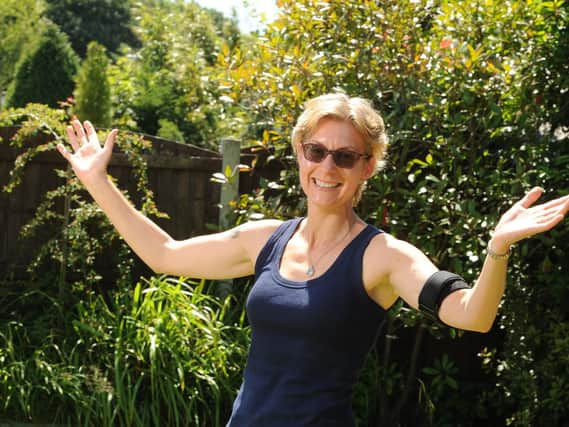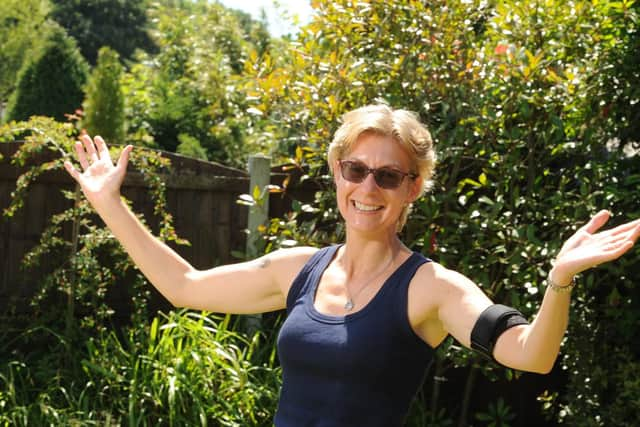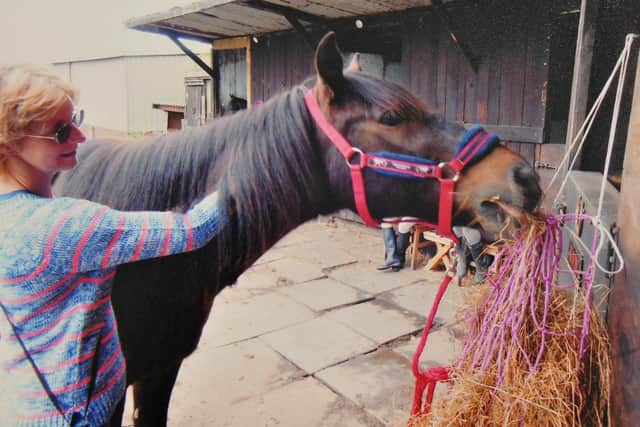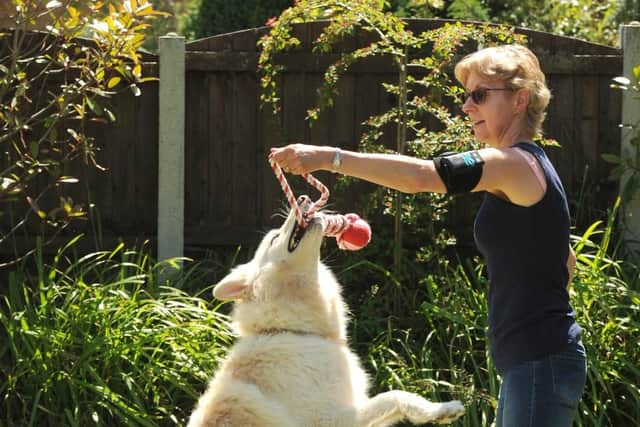Lancashire woman finds relief from ME by wearing microcurrent device


Dawn Bramwell tells AASMA DAY her story and her amazing achievements, despite battling with severe pain and plunging energy levels.
Life is like a constant game of snakes and ladders for Dawn Bramwell – no sooner has she climbed a ladder and hit a high in life, she comes face-to-face with a hissing snake and comes slithering back down again.
Advertisement
Hide AdAdvertisement
Hide AdDawn, now 50, who lives in Barton, near Preston, was first diagnosed with Chronic Fatigue Syndrome, also known as ME, at the age of 19 following years of struggling with extreme exhaustion and fatigue.


Dawn, who has been married to Tony for 30 years and has daughter Maggie, 27 and son Guy, 25, recalls: “I had a severe case of glandular fever when I was 15 and at high school and was in bed for a good number of months.
“I never really recovered properly after that and struggled with extreme tiredness and at the time, they wrongly diagnosed me with depression.”
Things came to a head when Dawn was 19 and was working for an employment agency at the time. She remembers trying to get up from her desk and not being able to walk properly.
Advertisement
Hide AdAdvertisement
Hide AdDawn says: “My body was shaking and my voice was slurring and I just collapsed.


“One of my bosses drove me home.”
Dawn had been going backwards and forwards to the doctors for years. However, this time when she saw a doctor, he realised what was wrong and referred her to another doctor and this led to her diagnosis of Chronic Fatigue Syndrome.
For the next year, Dawn was barely able to move and relied on her mum to help her bathe and dress. With severe pain all over her body and unable to walk, wash, dress or even cut up her own food, Dawn lost her job, her independence and her social life, relying on her mother to help with everyday tasks.
A year after her first attack and just coming out of the acute stage, Dawn got married to Tony, but was still reliant on her mum popping in every day to help with household tasks.


Advertisement
Hide AdAdvertisement
Hide AdDawn says: “My husband was incredibly supportive – and he still is – and he helped me through the dark days.
“But we both encountered a lot of prejudice with many people disbelieving my illness and assuming I was a hypochondriac.
“As it is an invisible illness, people thought I looked absolutely fine and said things like: ‘It’s all in your mind’ or ‘Pull yourself together.’
“As if someone at the age of 19 or of any age would choose to spend the best part of a year in bed unable to do anything.
Advertisement
Hide AdAdvertisement
Hide Ad“I still get some prejudice now but to a far lesser degree. People are more accepting if not understanding.”
Over subsequent years, Dawn’s Chronic Fatigue Syndrome was hard and becoming a mum was difficult, and she still needed her own mum for a lot of support.
Dawn remembers: “At this point, I was gradually getting over the worst and was in a recovery stage.
“With ME, you can have very severe bouts and then go through recovery stages.
Advertisement
Hide AdAdvertisement
Hide Ad“But it is like a volcano – it is always lying there waiting to erupt.
“You learn to try to avoid the pitfalls.”
Dawn wanted to take control of her life and decided to strengthen her body through exercising. She explains: “It was my way of showing myself and everybody else that I was not a hypochondriac or a malingerer, and that I was determined to fight this.”
Dawn took up karate and over a few years, managed to get her black belt. Unfortunately, a back injury put an end to her karate training.
Dawn then got into horse-riding and got a horse called Sam, who she smilingly describes as “the love of her life.”
Advertisement
Hide AdAdvertisement
Hide AdDawn had her horse for six years and after she no longer had a horse, she decided to join the gym.
Dawn says: “I have never been able to work full-time as whenever I tried, I would burn out within two months.
“So I have always worked part-time doing a variety of jobs and alongside that, I have always tried to be as active as I can be.
“It is a battle between not exhausting myself, but equally doing as much as I can do.”
Advertisement
Hide AdAdvertisement
Hide AdDawn was working in childcare at the time she joined the gym and surprised herself by finding she was good at gym training. Throwing herself into an exercise regime led Dawn to crash and burn several times so she began calculating exactly how much exercise she was able to do while still balancing her part-time job in childcare and being a mother.
Dawn says: “I was experimenting with myself to see if it was possible for me to get myself so fit that I could over-ride the ME.
“The answer was sadly no but what the fitness did do was to give me more of a buffer between me and the ME and enable me to cope with it better.”
Perseverance paid off and Dawn was soon strong enough to train as a personal trainer and sports massage therapist, and she left her job in childcare to set up her own business.
Advertisement
Hide AdAdvertisement
Hide AdIn 2013, Dawn came third in a national CrossFit competition. However, the impact of her extreme training led to a relapse.
Dawn says: “Sadly, I over-did things and crashed afterwards.
“It was then a question of reducing what I do.
“The last five years have been about exploring the boundaries I can push myself to without over-exerting myself with the ME.”
Ruefully, Dawn adds: “I still get it wrong!
“Managing my energy levels became an extreme balancing act. If I trained too hard in the gym, I was left unable to do as much work as my energy levels are finite.
Advertisement
Hide AdAdvertisement
Hide Ad“I know that I can only run my body’s battery down to about 30 per cent while most people can run to zero before ‘recharging’.
“I knew that I had to go to bed at 9pm and that I had to have a nap in the daytime to be able to avoid crashing and burning. I also knew that, even after a long sleep at night, I would not feel rested the next day.
“Life was a constant game of snakes and ladders.”
In December 2017, Dawn developed excruciating pain in her wrists, losing all use of her right wrist and was diagnosed with repetitive strain injury – which was no good for her job as a sports therapist.
One of her clients had told her about a new device called the Arc4Health, which promotes faster healing through microcurrent therapy that he had bought for his mother-in-law who was suffering from arthritis.
Advertisement
Hide AdAdvertisement
Hide AdAfter researching the device, Dawn ordered one and was impressed by how quickly her wrists improved and recovered.
Dawn says: “Within four weeks, I was able to continue working and was very impressed.
“I rang the company to talk to them about the possibility of it helping with Chronic Fatigue Syndrome and they gave me anecdotal evidence.”
Arc4Health is a discreet, portable and easy-to-use device which promotes faster healing through painless microcurrent therapy.
Advertisement
Hide AdAdvertisement
Hide AdIn our bodies, every cell communicates with all other cells by a series of minute sequences of electrical current which regulate the proper functioning of the body.
When disease, injury or stress is present, these currents are compromised resulting in the impairment of natural healing processes.
Using microcurrent therapy, the treatment kickstarts and accelerates many processes involved with correct cellular functioning resulting in faster healing and promoting optimal health.
Dawn uses the unit daily for three to six hours a day. She says: “It is like an armband or you can put it around your calf.
Advertisement
Hide AdAdvertisement
Hide Ad“It is just incredible. For the first time in my adult life, I found I woke up feeling like I’ve slept.
“I had more energy throughout the day, could run further on the treadmill and get through the day without sleeping.
“I am currently having one of my ME crashes, but that has come on the back of a very intensive six-month period where I have been incredibly busy on the home front.
“The last six months have been busier than I would have thought my body would have allowed and I am pretty sure I couldn’t have done everything I have in the last six months without this device and would have been more poorly.”
Advertisement
Hide AdAdvertisement
Hide AdDawn is quick to explain the device is not a cure for ME – but believes it helps her body cope with it better.
She says: “I know I still have my limits; living with Chronic Fatigue Syndrome for 30 years has made me wary of overdoing things but it is obvious to me that my limits have been increased exponentially by the Arc4Health Unit.
“This is not a cure for ME as there is not a cure.
“But I believe it helps me cope with it better and I hope it is going to help me recover quicker from an ME crash.
“This device was first developed to help horses and then they thought: ‘why not use it on humans too?’
Advertisement
Hide AdAdvertisement
Hide Ad“One of my clients has recently done a marathon for the first time and used this device with his training.
“I have another client who also has Chronic Fatigue Syndrome and she has seen the benefits of this device too.
“We both sum it up as being like ‘plugging ourselves into a battery charger’.
“For me, ME is like having a faulty battery charger.
“I can do things, but I won’t recover quickly and I never really get back to being fully charged.
Advertisement
Hide AdAdvertisement
Hide Ad“I am now in a re-charging phase and am hoping this device will help me do that quicker. I hope my story encourages other people with ME that it is still possible to do things. It does limit you and restrict you and can be a frustrating illness but if you are determined, you can still achieve what you want.”
Microcurrent therapy
Microcurrent therapy has been used in Europe and America over the last two decades and has been refined to such an extent that the method is generally regarded as a safe, convenient and drug-free solution to pain like backache, arthritis and sciatica.
The Arc4Health device has developed from successful use of microcurrent technology with injured horses and trials using it proved effective in helping horses rehabilitate and return to competition and normal, everyday exercise.
Understanding that this technology could have a profound effect on recovery in humans, the company Arc Family carried out a five-year £150,000 research and development programme to adapt the technology for specific human use.
Advertisement
Hide AdAdvertisement
Hide AdIt recently gained full regulatory approval for use on humans and is an EC certified Class 11a medical device.
It involves the passing of naturally occurring electrical currents into the body by way of self-adhesive electrodes within the arm strap. The technology works systematically at cellular level, so it doesn’t matter where the currents are introduced to the body, they go to wherever they are required.
The patient activates the treatment allowing a bio-electrical current to flow to the area of pain.
For more information, visit: www.arc4health.com